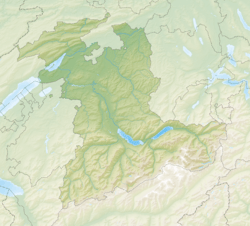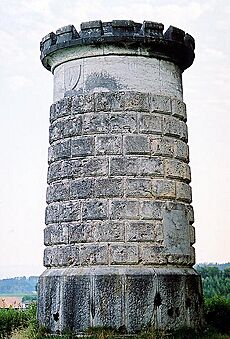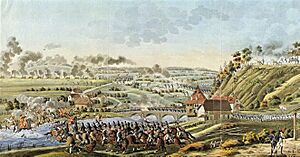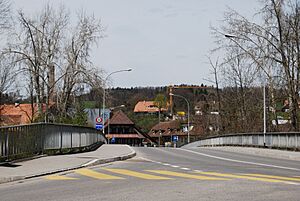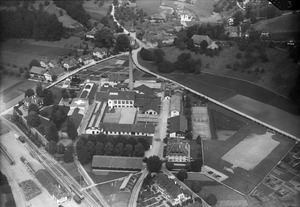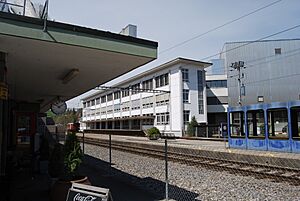Neuenegg facts for kids
Quick facts for kids
Neuenegg
|
||
|---|---|---|
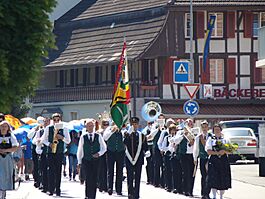
Student procession in 2011, led by the Sternenberg Neuenegg Music Society
|
||
|
||
| Country | Switzerland | |
| Canton | Bern | |
| District | Bern-Mittelland | |
| Area | ||
| • Total | 21.83 km2 (8.43 sq mi) | |
| Elevation | 525 m (1,722 ft) | |
| Population
(Dec 2020 )
|
||
| • Total | 5,601 | |
| • Density | 256.57/km2 (664.52/sq mi) | |
| Postal code |
3176
|
|
| Localities | Au, Bärfischenhaus, Bramberg, Brüggelbach, Freiburghaus, Süri, Thörishaus, Wyden | |
| Surrounded by | Bern (Bern), Bösingen (FR), Köniz, Laupen, Mühleberg, Ueberstorf (FR), Wünnewil-Flamatt (FR) | |
Neuenegg is a town, also called a municipality, in Switzerland. It is located in the Bern-Mittelland area within the canton of Bern.
Contents
History of Neuenegg
Neuenegg was first mentioned in old writings in 1228. Back then, it was called Nuneca. A few years later, in 1235, it was known as Nuwenegge.
Early Days and the Battle of Laupen
During the Middle Ages, Neuenegg was part of a larger area called the Herrschaft of Laupen. In 1324, the city of Bern bought this entire area. Neuenegg then became one of the six courts in Bern's new bailiwick (a type of district) of Laupen. At first, court meetings were held in the churchyard, then they moved to the local pub.
A very important event happened in 1339: the Battle of Laupen. Forces from Bern and the Swiss Confederation gathered on the Bramberg hill near Neuenegg. Armies from Fribourg, Burgundy, and the Habsburg family attacked the hill. After a tough fight, the Bernese and Swiss soldiers pushed them back, causing many losses for the attackers. This victory on the Bramberg hill brought Bern much closer to the Swiss Confederacy. Bern officially joined the group of the Eight Cantons in 1353.
Church and School
The village's parish church of St. John was first mentioned in 1227. At that time, Emperor Frederick II gave it to the Teutonic Knights. The main part of the church, called the aisle, was built in the 13th or 14th century. The choir (the area where the choir sits) was added in 1452, and the church tower was built between 1512 and 1516. The first school in the village opened in the 17th century.
French Invasion and Later Developments
In 1798, during the French invasion of Switzerland, a big battle took place near Neuenegg. Under the leadership of Johann Rudolf von Graffenried, the soldiers from Bern won against more numerous French troops. This happened on March 5, 1798. However, on the very same day, the Bernese lost another battle at Battle of Grauholz. This meant the old government system, called the Ancien Régime, could not survive.
Neuenegg was once on an important trade road between Bern and Fribourg. In 1470, Fribourg built a bridge over the Sense River at Neuenegg. This made the road go directly through the town. Neuenegg stayed on this main road for several centuries. But in the 1800s, a new main road was built that went around Neuenegg. Then, in 1860, a railroad line was built, which also bypassed the village. It wasn't until 1903 that a train line, the Flamatt-Gümmenen line, was finally built through the town.
In the same year, the famous company Nestlé opened a milk factory in Neuenegg. In 1927, another company called Wander AG bought the factory to make Ovaltine. Later, in 1967, Sandoz AG and Novartis AG took over the factory when they bought Wander. Today, since 2002, Associated British Foods owns the factory. It is still one of the biggest employers in Neuenegg.
Geography of Neuenegg
Neuenegg covers an area of about 22 square kilometers (8.5 square miles). A large part of this land, about 52.5%, is used for farming. Forests cover about 38.2% of the area. Buildings and roads take up about 9.0% of the land. A small part, 0.7%, is made up of rivers or lakes.
Most of the forested land is dense forest. For farming, about 35.7% is used for growing crops, and 15.0% is used for pastures where animals graze.
Neuenegg is located on a flat area, or plateau, on the right side of the Sense River. The municipality includes the main village of Neuenegg. It also includes half of the village of Thörishaus and several smaller villages or hamlets. These include Bärfischenhaus, Bramberg, Brügelbach, and Landstuhl. Part of a nature preserve called the Forsts is also within Neuenegg.
On January 1, 2010, Neuenegg became part of a new administrative area called Verwaltungskreis Bern-Mittelland. Before that, it was in a district called Amtsbezirk Laupen, which was dissolved.
Coat of Arms
The blazon (description) of Neuenegg's municipal coat of arms is: a gold star on a blue background, above three green hills.
People of Neuenegg (Demographics)
Neuenegg has a population of about 4,885 people (as of December 2011). About 9.5% of the people living in Neuenegg are foreign nationals. Over the past ten years, the population has changed only a little, growing by about 0.2%.
Languages Spoken
Most people in Neuenegg speak German as their first language (about 93%). French is the second most common language, spoken by about 1.1% of the population. Italian is spoken by about 0.7%.
Age Groups and Marital Status
As of 2011, children and teenagers (ages 0–19) make up about 19.9% of the population. Adults (ages 20–64) make up 60.7%, and seniors (over 64 years old) make up 19.4%.
In 2000, about 30.1% of the people living in Neuenegg were born there. Many others were born in the same canton (39.6%) or elsewhere in Switzerland (17.7%). About 9.6% were born outside of Switzerland.
Population Changes Over Time
The chart below shows how the population of Neuenegg has changed over many years:

Economy of Neuenegg
In 2011, Neuenegg had a low unemployment rate of 2.16%. In 2008, there were 1,849 people working in the municipality. These jobs are divided into three main types:
- Primary sector: This involves jobs like farming. About 260 people worked in this area, with 78 businesses.
- Secondary sector: This includes jobs in manufacturing (making things) and construction. About 671 people worked here, with 45 businesses. Most of these jobs (89.7%) were in manufacturing.
- Tertiary sector: This covers jobs that provide services, like retail, transport, hotels, education, and healthcare. About 918 people worked in this sector, with 126 businesses.
Many people who live in Neuenegg also work there. In 2000, about 718 workers both lived and worked in the municipality. However, more people leave Neuenegg for work than come into it.
For getting to work, about 21.9% of working people used public transportation. A larger number, 53.8%, used a private car.
Transport in Neuenegg
Neuenegg is easy to reach. The A12 motorway passes nearby. The town also has a train station on the Swiss Federal Railways line, called Neuenegg. You can also get around by bus, with a line connecting Neuenegg to Thörishaus Dorf.
Religion in Neuenegg
Based on a 2000 survey, most people in Neuenegg belong to the Swiss Reformed Church (about 71.3%). The next largest group is Roman Catholic, making up about 13.2% of the population.
Smaller numbers of people belong to other Christian churches, including Orthodox and Christian Catholic. There are also people who follow Islam (about 1.54%), Buddhism, and Hinduism. About 6.53% of the population said they did not belong to any church, or were agnostic or atheist.
Education in Neuenegg
In Neuenegg, about 56.4% of adults have finished non-mandatory upper secondary education. This means they went to school beyond the basic required years. About 20.5% have gone on to higher education, like a university or a specialized college (a Fachhochschule).
School System
The school system in the Canton of Bern works like this:
- One year of non-required Kindergarten.
- Six years of Primary school.
- Three years of required lower Secondary school. In this stage, students are grouped based on their abilities.
After lower Secondary school, students can choose to continue their education or start an apprenticeship (learning a trade on the job).
During the 2011–2012 school year, 579 students attended schools in Neuenegg.
- There were 6 kindergarten classes with 98 students.
- There were 19 primary classes with 321 students.
- There were 9 lower secondary classes with 160 students.
Many students in Neuenegg's schools are either permanent or temporary residents of Switzerland but not citizens. Also, a number of students speak a different language at home than the one used in the classroom.
Library
Neuenegg has its own public library, called the Schul- und Gemeindebibliothek Neuenegg. In 2008, the library had over 10,830 books and other media. It loaned out more than 26,000 items that year.
See also
 In Spanish: Neuenegg para niños
In Spanish: Neuenegg para niños




